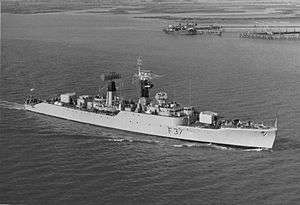HMS Jaguar (F37)
.jpg) HMS Jaguar in 1963 | |
| History | |
|---|---|
| Name: | HMS Jaguar (F37) |
| Ordered: | 28 June 1951 |
| Builder: | William Denny and Brothers |
| Laid down: | 2 November 1953 |
| Launched: | 20 July 1957 |
| Commissioned: | 12 December 1959 |
| Fate: | Sold to Bangladesh 1978 |
| General characteristics | |
| Class and type: | Leopard-class frigate |
| Length: | 101 metres (331 ft) |
| Beam: | 10.6 metres (35 ft) |
| Draught: | 3 metres (9.8 ft) |
| Propulsion: |
|
| Speed: | 18 knots |
| Range: | 2200 miles at 18 kts |
| Complement: | 200 (22(app.) officers) |
| Sensors and processing systems: |
|
| Armament: |
|
HMS Jaguar (F37), was a Leopard-class Type 41 anti aircraft frigate of the British Royal Navy, named after the jaguar. The Jaguar was the last frigate built by William Denny and Brothers for the Royal Navy.[1] Unlike the rest of her class, the Jaguar was fitted with controllable pitch propellers.[2]
Royal Navy service
The main armament originally consisted of twin Bofors 40 mm guns on a STAAG mounting, which was replaced by a single 40 mm gun early in life.[3]
She was refitted in the mid-1960s, replacing the Type 960 long-range air warning radar with Type 965. The lattice mainmast was replaced by a plated structure to support the heavier AKE1 aerial used by the Type 965. The Type 293Q target designation radar on the foremast was replaced by Type 993. New ESM and SCCM equipment was installed on the foremast. It was intended that Seacat missile would replace the 40 mm gun, but this was not done to save money.[4]

The Jaguar sailed from Chatham UK in January 1969 and undertook a world cruise calling at Gibraltar, South Africa, Mombasa, Singapore, Hong Kong, New Zealand, Australia, Tasmania, Fiji, Tonga, Raratonga, Tahiti, Pitcairn, Panama and Florida. During this cruise she provided medical aid at Astove, in the Seychelles.[5] She arrived back in UK December 1969. She was deployed to Icelandic waters for the Second Cod War in 1973.[4] On 10 September 1973, she collided with the Icelandic gunboat Thor (Þór),[6] and had her bows damaged.[7] She spent the rest of the month on dry dock for repairs at Chatham.[8] She was then assigned to the standby squadron,[4] but was recommissioned in 1976 for service in Icelandic waters again for the Third Cod War. To protect her bows and stern from damage from collisions with Icelandic gunboats, she was fitted with heavy wooden sheathing.[9]
Bangladesh Navy Service
After a spell in reserve,[4] she was sold on 6 July 1978 to the Bangladesh Navy for £2 million,[1][10] and commissioned in 1978 as BNS Ali Haider (F17).[1][11] Ali Haider served as a training ship.[1]
She was decommissioned during a ceremony held in her homeport Chittagong on 22 January 2014.[12] Name and number were taken by one of the two former Chinese JIANGHU III class frigates which reportedly had already begun their transfer voyage.
See also
References
- 1 2 3 4 Bangladesh Military Force Leopard Class Patrol Frigate last accessed 21 December 2010. Note that the BdMilitary web-page appears to have the dates the Ali Haider and Abu Bakr were commissioned into the Bangladeshi Navy transposed.
- ↑ Marriott, Leo, Royal Navy Frigates since 1945, 2nd Edition, pub Ian Allan, 1990, ISBN 0-7110-1915-0 page 54.
- ↑ Marriott, Leo, Royal Navy Frigates since 1945, 2nd Edition, page 55. The photograph on page 55 shows the Jaguar with the Type 960 and 293Q radars and without STAAG in 1964 – before her mid-60s refit.
- 1 2 3 4 Marriott, Leo, Royal Navy Frigates since 1945, 2nd Edition, page 56.
- ↑ Royal Navy post-World War 2 CHRONOLOGY, Part 3 - 1961-70, by Geoffrey B Mason, Lieutenant Commander, RN (Rtd), 2007
- ↑ The National Archives - Piece reference ADM 330/80
- ↑ "Ships collide off Iceland". 10 September 1973. Retrieved 11 April 2016 – via Associated Press.
- ↑ Boniface, Patrick (2006). Cats and Cathedrals. Periscope Publishing Ltd. p. 141. ISBN 1904381359.
- ↑ Marriott, Leo, Royal Navy Frigates since 1945, 2nd Edition, pages 56–57.
- ↑ Gardiner, Robert Conway's All the World's Fighting Ships 1947-1995, pub Conway Maritime Press, 1995, ISBN 0-85177-605-1 page 23.
- ↑ Gardiner, Robert Conway's All the World's Fighting Ships 1947-1995, page 516.
- ↑ "BNS Abu Bakar, BNS Ali Haider de-commissioned". Dhaka Tribune. 22 January 2014. Retrieved 5 May 2014.
Publications
Colledge, J. J.; Warlow, Ben (2006) [1969]. Ships of the Royal Navy: The Complete Record of all Fighting Ships of the Royal Navy (Rev. ed.). London: Chatham Publishing. ISBN 978-1-86176-281-8. OCLC 67375475.